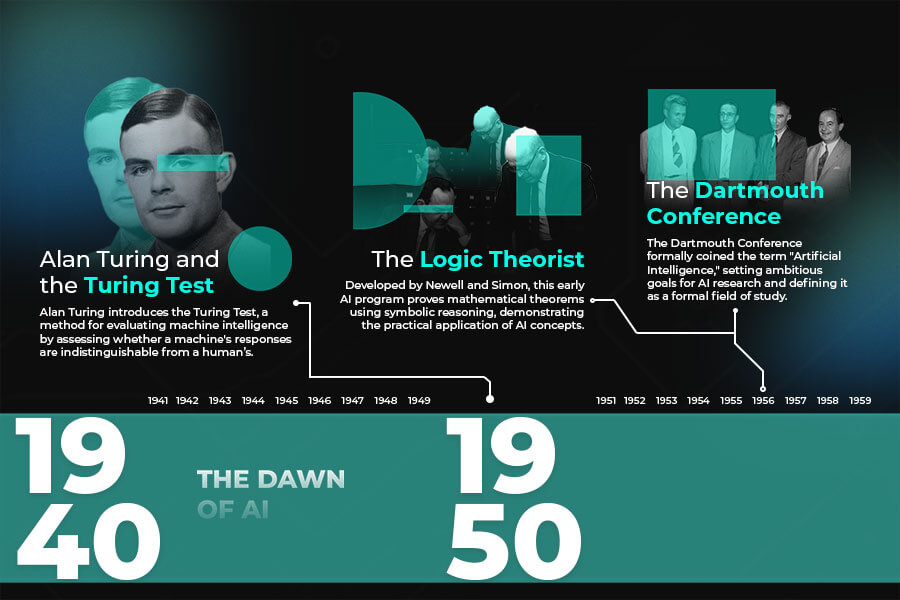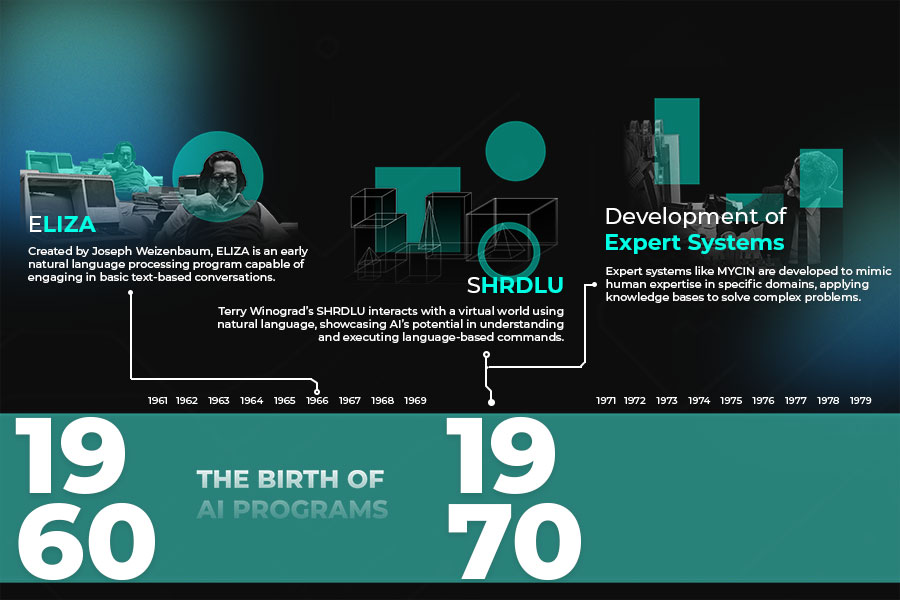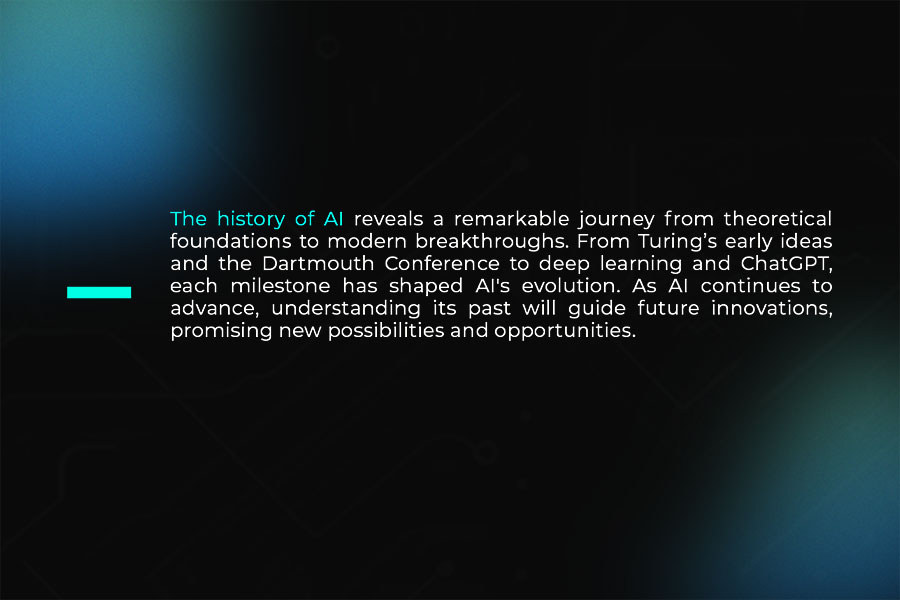
The journey through the history of AI—from its theoretical origins in the 1940s to the groundbreaking release of ChatGPT in 2022—is nothing short of extraordinary. What began as a theoretical concept, dreamt up by pioneers like Alan Turing, has evolved into one of the most transformative technologies of our era. Each milestone in this journey has not only advanced our understanding of AI but has also reshaped the way we interact with and leverage technology in our daily lives.
From the landmark Dartmouth Conference of 1956, where the term “Artificial Intelligence” was first coined, to the era of deep learning and neural networks that sparked AI’s modern renaissance, the history of AI is marked by both triumphs and setbacks. Key achievements, such as IBM’s Watson and Google’s AlphaGo, demonstrated AI’s immense potential and paved the way for the conversational capabilities of GPT-3 and its successor, ChatGPT.
This article will chronicle these pivotal moments in the history of AI, providing a comprehensive overview of AI’s development and its impact over the decades. Whether you’re a tech enthusiast, a professional in the field, or simply curious about AI’s evolution, this exploration of AI’s major milestones will offer valuable insights into how far we’ve come—and where we might be headed next.
The Dawn of AI (1940s-1950s)

The early years of artificial intelligence laid the groundwork for the field’s development with groundbreaking theories and visionary conferences. This era marked the beginning of AI as both a concept and a formal discipline, driven by pioneering individuals who envisioned machines capable of intelligent behavior. The following milestones illustrate how foundational ideas and key events shaped the trajectory of AI research and set the stage for future advancements.
Alan Turing and the Turing Test (1950)
Alan Turing’s introduction of the Turing Test in 1950 established a foundational criterion for evaluating machine intelligence by assessing whether a machine’s responses are indistinguishable from a human’s.
In 1950, Alan Turing, a British mathematician and logician, published his seminal paper “Computing Machinery and Intelligence,” which posed a revolutionary question: “Can machines think?”
Turing introduced the concept of the Turing Test as a method for determining whether a machine could exhibit intelligent behavior comparable to that of a human. The test involves a human evaluator engaging in a text-based conversation with both a machine and a human, without knowing which is which. If the evaluator cannot reliably distinguish between the machine and the human, the machine is said to have passed the test.
This idea provided a theoretical benchmark for assessing machine intelligence and inspired future research into developing intelligent systems. Turing’s work laid the philosophical and theoretical groundwork for AI, influencing the evolution of computing and machine learning.
The Dartmouth Conference (1956)
The 1956 Dartmouth Conference formally coined the term “Artificial Intelligence” and set the ambitious goal of exploring whether all aspects of human intelligence could be simulated by machines.
The Dartmouth Conference, held in the summer of 1956 at Dartmouth College in Hanover, New Hampshire, is widely recognized as the birth of AI as a formal field of study. Organized by John McCarthy, Marvin Minsky, Nathaniel Rochester, and Claude Shannon, the conference was pivotal in coining the term “Artificial Intelligence.”
The event aimed to explore the potential of machine intelligence, proposing that “every aspect of learning or any other feature of intelligence can in principle be so precisely described that a machine can be made to simulate it.” This vision set ambitious goals for AI research and outlined the possibility of replicating human cognitive processes in machines.
The conference brought together leading researchers who discussed and debated the challenges and possibilities of developing intelligent machines. The ideas and goals set during this event shaped the future direction of AI research, marking the beginning of AI as a distinct and systematic field of inquiry.
The Birth of AI Programs (1960s-1970s)

The 1960s and 1970s were pivotal decades in the history of artificial intelligence, characterized by the development of the first AI programs and significant advancements in machine learning. This period saw the transition from theoretical concepts to practical applications, with early AI systems demonstrating the potential of artificial intelligence in real-world tasks. The following milestones highlight the key achievements and innovations of this era.
The Logic Theorist (1956)
The Logic Theorist, developed by Allen Newell and Herbert A. Simon in 1956, is considered one of the first AI programs, demonstrating the practical application of AI concepts by solving mathematical theorems.
In 1956, just after the Dartmouth Conference, Allen Newell and Herbert A. Simon developed the Logic Theorist, a pioneering AI program that could prove mathematical theorems. Designed to simulate human problem-solving, the Logic Theorist used symbolic reasoning to solve problems that had previously been addressed by human mathematicians. This early AI system was capable of applying logical rules to generate proofs, showcasing the potential of machine intelligence in handling complex tasks.
The success of the Logic Theorist marked a significant step in AI development, illustrating that machines could perform tasks that required abstract reasoning and problem-solving skills. This breakthrough laid the groundwork for future AI research and applications.
ELIZA (1966)
ELIZA, created by Joseph Weizenbaum in 1966, was one of the first natural language processing programs, capable of engaging in basic conversations with users using a pattern-matching approach.
In 1966, Joseph Weizenbaum developed ELIZA, an early natural language processing program designed to simulate conversation with a human user. It used pattern-matching techniques to generate responses to user inputs, mimicking the style of a psychotherapist in its interactions. Despite its simplicity, the program demonstrated the potential of machines to understand and generate human-like text.
ELIZA’s design was based on the idea of “scripted” conversation, where the program followed predefined patterns and responses to engage users in dialogue. Although it was not truly understanding language, it’s ability to engage in conversation paved the way for future developments in natural language processing and human-computer interaction.
SHRDLU (1970)
SHRDLU, developed by Terry Winograd in 1970, was an early AI program that demonstrated the ability to understand and manipulate a virtual world using natural language instructions.
In 1970, Terry Winograd created SHRDLU, an AI program that could interact with a virtual world using natural language. SHRDLU operated within a simulated environment of colored blocks and demonstrated the ability to understand and execute commands given in natural language. For example, users could instruct SHRDLU to move blocks or arrange them in specific patterns, and the program would accurately perform the requested tasks.
SHRDLU’s success was notable for its ability to bridge the gap between human language and machine action, showcasing the potential of AI to handle complex tasks based on natural language inputs. This program contributed to the development of more sophisticated AI systems and highlighted the possibilities for integrating language understanding with machine learning.
The Development of Expert Systems (1970s)
The 1970s saw the emergence of expert systems, which were designed to mimic human expertise in specific domains, such as medical diagnosis and problem-solving.
During the 1970s, the field of AI witnessed the development of expert systems, programs designed to simulate human expertise in specific domains. These systems used knowledge bases and inference engines to provide solutions and recommendations based on the input data. Early expert systems, such as MYCIN for medical diagnosis, demonstrated the ability to apply domain-specific knowledge to real-world problems.
Expert systems marked a significant advancement in AI by moving beyond theoretical concepts to practical applications. They showcased the potential for AI to assist in complex decision-making processes and provided valuable insights into the application of AI in various professional fields.
AI Winter and Resurgence (1980s-1990s)

The 1980s and 1990s were marked by a period of both setbacks and renewed interest in artificial intelligence. After initial enthusiasm in the 1960s and 1970s, AI research faced significant challenges, leading to what is known as the “AI Winter,” where funding and interest in AI research declined. However, the latter part of this period saw a resurgence in AI research, driven by new approaches and technological advancements. This section outlines the key milestones of this era that shaped the future of AI.
The Rise and Fall of Expert Systems (1980s)
In the 1980s, expert systems gained prominence as early applications of AI but faced limitations that led to reduced enthusiasm and the onset of the AI Winter.
The 1980s saw the rise of expert systems, which were among the first practical applications of AI technology. These systems, such as XCON (also known as R1) developed by Digital Equipment Corporation, were designed to emulate the decision-making capabilities of human experts in specific domains. Expert systems applied rule-based reasoning to solve complex problems and were widely adopted in various industries, including medical diagnosis, finance, and engineering.
However, expert systems faced significant limitations, such as difficulty in scaling and maintaining knowledge bases, and their reliance on predefined rules made them inflexible in dealing with unforeseen scenarios. As the limitations of these systems became apparent and the cost of developing and maintaining them rose, funding and enthusiasm for AI research waned, leading to a period known as the AI Winter.
The Emergence of Machine Learning (1990s)
The 1990s marked a resurgence in AI research with the rise of machine learning techniques, which began to address the limitations of earlier AI systems and showed promise for future advancements.
The 1990s witnessed a resurgence in AI research, driven by the development and refinement of machine learning techniques. Machine learning, which focuses on developing algorithms that enable computers to learn from and make predictions based on data, offered a new approach to overcoming the limitations of earlier AI systems. Key advancements included the introduction of algorithms such as support vector machines and neural networks, which demonstrated improved performance in various tasks.
Notable achievements during this period included IBM’s Deep Blue defeating world chess champion Garry Kasparov in 1997, a landmark event that highlighted the potential of AI in complex decision-making and problem-solving. The success of Deep Blue demonstrated that AI could excel in domains requiring strategic thinking and computation, leading to renewed interest and investment in AI research.
The Advent of Data-Driven AI (Late 1990s)
The late 1990s saw the advent of data-driven AI approaches, leveraging large datasets and computational power to drive advances in areas such as speech recognition and computer vision.
In the late 1990s, advancements in computational power and the availability of large datasets paved the way for data-driven AI approaches. Researchers began to leverage vast amounts of data to train algorithms, leading to significant improvements in areas such as speech recognition, computer vision, and natural language processing. This shift towards data-driven methods enabled AI systems to learn from large volumes of data and improve their performance on various tasks.
For example, the development of more sophisticated algorithms for speech recognition and computer vision demonstrated the potential of data-driven AI to achieve practical results and solve real-world problems. The increased focus on data and computational resources set the stage for the next wave of AI advancements and laid the foundation for the breakthroughs of the 21st century.
The Era of Modern AI (2000s-2022)

The turn of the 21st century marked a transformative period for artificial intelligence, characterized by rapid advancements and breakthroughs that reshaped the field. This era saw the emergence of powerful algorithms, unprecedented computational capabilities, and significant applications of AI in everyday life. Key milestones of this period highlight the progress and impact of AI as it evolved into a critical component of modern technology.
The Rise of Deep Learning (2000s)
The 2000s saw the rise of deep learning, a subset of machine learning that leverages neural networks with multiple layers to achieve significant advancements in AI performance.
In the early 2000s, deep learning began to gain prominence as a powerful approach within the field of machine learning. Deep learning involves the use of neural networks with many layers (deep neural networks) to model complex patterns in data. This approach proved to be highly effective in tasks such as image and speech recognition, natural language processing, and game playing.
One of the pivotal moments in this era was the development of AlexNet by Alex Krizhevsky, Ilya Sutskever, and Geoffrey Hinton in 2012. AlexNet demonstrated a significant breakthrough in image classification tasks by winning the ImageNet competition with a substantial margin. This success highlighted the potential of deep learning algorithms and set the stage for further advancements in the field.
The Advent of AI Assistants (2010s)
The 2010s witnessed the widespread adoption of AI assistants, such as Siri, Google Assistant, and Alexa, which brought AI into everyday consumer technology and demonstrated its practical applications.
The 2010s marked the advent of AI-powered virtual assistants, which became integral to consumer technology. AI assistants like Apple’s Siri (released in 2011), Google Assistant (2016), and Amazon’s Alexa (2014) demonstrated the practical applications of AI in everyday life. These virtual assistants used natural language processing and machine learning to understand and respond to user queries, manage tasks, and control smart devices.
The widespread adoption of AI assistants showcased the ability of AI to enhance user experiences by providing intuitive and interactive interfaces. These assistants also served as platforms for integrating various AI technologies and paved the way for more sophisticated applications of AI in daily life.
Breakthroughs in Natural Language Processing (Late 2010s)
The late 2010s saw significant breakthroughs in natural language processing with the development of advanced language models, such as GPT-3, which demonstrated remarkable capabilities in understanding and generating human-like text.
The late 2010s brought groundbreaking advancements in natural language processing (NLP) with the development of advanced language models. One of the most notable breakthroughs was the release of OpenAI’s GPT-3 (Generative Pre-trained Transformer 3) in 2020. GPT-3, with its 175 billion parameters, demonstrated unprecedented capabilities in generating human-like text, understanding context, and performing various language-related tasks.
The success of GPT-3 and similar models showcased the potential of AI to handle complex language tasks, including text generation, translation, summarization, and question-answering. These advancements marked a significant leap forward in NLP and highlighted the growing capabilities of AI in understanding and interacting with human language.
The Release of ChatGPT (2022)
The release of ChatGPT in 2022 marked a milestone in conversational AI, offering advanced capabilities in generating coherent and contextually relevant responses, and showcasing the latest advancements in natural language understanding.
In 2022, OpenAI released ChatGPT, a cutting-edge conversational AI model based on the GPT-3 architecture. ChatGPT was designed to engage in natural and coherent conversations with users, offering contextually relevant responses and demonstrating advanced capabilities in understanding and generating human-like text. The model’s ability to handle complex dialogues and provide detailed answers made it a significant advancement in conversational AI.
The release of ChatGPT exemplified the progress made in AI technologies and their applications, highlighting the potential of AI to enhance communication and interaction in various contexts. It represented the culmination of years of research and development in natural language processing and set a new standard for conversational AI.
Reflecting on AI’s Evolution: Discover More and Stay Ahead

The history of AI showcases a remarkable journey from theoretical foundations to groundbreaking advancements. From Alan Turing’s early ideas and the Dartmouth Conference’s foundational goals to the development of deep learning and the introduction of AI assistants, each milestone has significantly shaped AI’s evolution.
Despite early challenges, such as the AI Winter, the field has experienced a resurgence with data-driven approaches and sophisticated models like GPT-3 and ChatGPT. These developments underscore the incredible progress AI has made and its growing impact on our daily lives.
As AI continues to evolve, the lessons from its past will guide future innovations, promising new possibilities and opportunities. To stay informed about the latest advancements and explore how AI can shape your future, visit our website and dive deeper into the world of artificial intelligence.




